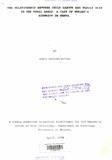| dc.contributor.author | Muturi, Nancy W | |
| dc.date.accessioned | 2013-05-07T13:16:53Z | |
| dc.date.available | 2013-05-07T13:16:53Z | |
| dc.date.issued | 1994 | |
| dc.identifier.citation | Masters of Arts degree in Sociology | en |
| dc.identifier.uri | http://erepository.uonbi.ac.ke:8080/xmlui/handle/123456789/19901 | |
| dc.description.abstract | This study is an analysis of child labour in relation to
family size in Kandara division of Murang'a district, Kenya.
Its main objective was to investigate the nature of the
relationship between the value of child labour and family
sizes in the area and to investigate factors that determine
children engagement in various domestic and agricultural
activities. It also aimed at examining whether there is any
relationship between the economic status of mothers and
family size. Other related variables such as mothers' age,
education level, her occupation and the families' income are
taken into consideration.
The sample was composed of women aged between 20 - 49 years
who were either single, married, divorced or widowed. A total
of 135 respondents were interviewed. They were selected
using systematic sampling from the four divisions of the
district. The study had four major hypotheses. The first hypothesis
stated that "the value of child labour within the family 1S
positively related to the size of the family" while the
second major hypothesis stated that "education level of the
mother is related to family size in that the more educated
mothers tend to have smaller families than the less educated
ones". Other hypotheses investigated the relationship
between occupation of the mother and participation of
children in the family labour, and lastly the family income
in relation to family size.
The study's major finding was that a relationship exists
between child labour and family size. A significant
relationship was also found to exist between mother's
education and family size. The more educated mothers tend to
have smaller families. Age was partly responsible for an
element of spurious relationship between mother's education
and family size. The study found no significant relationship
between income and family size, while occupation of the
mother was found to be significantly related to the amount of
labour contribution by children to the family.
At least two conclusions can be drawn from this study.
Firstly, it is to be noted that improved income of the rural
families has no effect on fertility. However, increased
education of women has the effect of reducing fertility
although age confounds educational effects to an extent. The
'" major factors that may be associate the education that
directly reduce fertility are delayed marriages and use of
contraceptives. Secondly, it is noted that occupational
status is associated with reduced fertility, in part because
women in higher occupational status can hire labour to
replace child labour. Thus reduced demand for child labour
by women in formal occupations encourages them to adopt birth
control methods in order to Limit; fertility. | en |
| dc.description.sponsorship | University of Nairobi | en |
| dc.language.iso | en | en |
| dc.title | The relationship between child labour and family size in the rural areas. | en |
| dc.title.alternative | A case of murang'a district in Kenya | en |
| dc.type | Thesis | en |
| local.publisher | Department of Sociology, University of Nairobi, | en |

